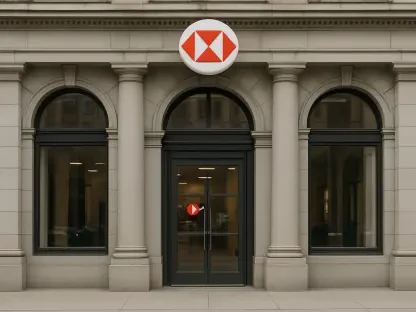Imagine a financial landscape where confidence in banks, insurance, and consumer finance companies is skyrocketing, with hedge funds leading the charge by pouring unprecedented capital into these sectors, reflecting a bold market reality. This isn’t just speculation but a tangible trend, as hedge funds have ramped up investments in financial stocks at a remarkable pace over recent months. This analysis dives deep into the reasons behind this aggressive pivot, exploring the market trends, economic factors, and strategic opportunities driving such optimism. The purpose here is to dissect these patterns, uncover what they mean for the broader market, and project potential outcomes for investors and industry stakeholders. By examining hard data and emerging dynamics, this piece aims to provide clarity on why financial stocks have become a focal point for hedge fund strategies.
Market Momentum: Financial Stocks on the Rise
Stellar Performance Across Regions
The financial sector has emerged as a powerhouse in global markets, with performance metrics that are hard to ignore. European banking indices have surged by over 40% in the current year, showcasing a robust recovery and investor enthusiasm. Meanwhile, U.S. banks have recorded solid gains exceeding 20%, reflecting a steady upward trajectory. Hedge funds, seizing on these trends, have taken substantial long positions across both regions without favoring one over the other. This balanced approach signals a deep-seated belief in the sector’s resilience and growth potential, positioning financial stocks as a cornerstone of their portfolios.
Sectoral Rankings and Investment Patterns
Further evidence of this trend lies in the purchasing behavior of hedge funds, where financial companies rank as the second most bought sector, just behind technology. Data from prime brokerage units indicates that the rapid accumulation of these stocks marks one of the fastest three-month increases in investment activity. This isn’t merely a fleeting interest but a calculated move to capitalize on rising share prices. However, potential headwinds such as economic slowdowns or geopolitical uncertainties loom on the horizon, suggesting that while the momentum is strong, it isn’t without risks that could test this bullish outlook.
Trading Volume as a Confidence Indicator
After a period of reduced activity in prior months, hedge funds have dramatically shifted gears, increasing gross leverage—a key measure of trading volume—by the largest margin in eight months during recent weeks. This sharp uptick reflects a renewed vigor and strategic intent to maximize exposure to financial stocks. Unlike quieter periods when caution dominated, the current landscape shows hedge funds doubling down on their bets, driven by a confluence of market strength and opportunistic timing. Such behavior underscores a pivotal moment where confidence in the sector’s trajectory is visibly translating into actionable investment decisions.
Key Catalysts Fueling Hedge Fund Optimism
Dealmaking Surge as a Profit Engine
A significant driver behind the hedge fund frenzy is the vibrant dealmaking environment within the financial sector. Recent weeks have witnessed a flurry of activity, including a peak in initial public offerings (IPOs) not seen in years, which directly benefits financial institutions acting as advisors and underwriters. This boom in transactions—ranging from mergers to acquisitions—creates a direct pathway to enhanced profitability, making the sector an attractive bet for hedge funds. While risks such as deal failures or market saturation persist, the current wave of activity offers a clear window for outsized returns.
Regulatory Environment and Economic Shifts
Adding another layer to this dynamic is the evolving regulatory and economic backdrop. In the U.S., the Federal Reserve’s recent interest rate cut, the first in months, alongside hints of further reductions due to labor market concerns, has not dampened investor sentiment. While banks historically thrive on higher rates for better net interest margins, market pricing appears to have already absorbed these changes, with focus shifting toward other growth levers like dealmaking. Additionally, in regions like the UK, pragmatic regulatory approaches have bolstered specialty lenders, leading to improved operational outcomes and share price appreciation, further fueling hedge fund interest.
Global Confidence Amidst Complexities
What stands out is the lack of regional bias in hedge fund investments, pointing to a global confidence in financial institutions’ prospects. Whether in Europe or North America, the sector’s appeal transcends borders, driven by a mix of strong fundamentals and strategic opportunities. Yet, complexities such as potential regulatory tightening or unexpected economic downturns remain as variables that could alter this trajectory. Despite these uncertainties, the alignment of market performance with favorable conditions suggests that hedge funds view the financial sector as a calculated risk worth taking.
Future Projections: What’s Next for Financial Stocks?
Technological and Operational Evolution
Looking ahead, the financial sector stands at a crossroads shaped by technological innovation and operational shifts. The rise of fintech and digital banking is redefining how institutions engage with clients, potentially unlocking new revenue streams while challenging traditional business models. Hedge funds are likely to monitor these developments closely, as companies that adapt swiftly could emerge as market leaders. This transformation, while promising, carries risks of disruption for slower-moving players, creating a dual-edged sword for investment strategies over the coming years.
Economic Variables and Market Sentiment
Economic factors, including further interest rate adjustments and labor market fluctuations, will continue to influence the sector’s outlook. While dealmaking activity may cushion short-term impacts, sustained economic instability could temper enthusiasm. Projections suggest that hedge funds will maintain their aggressive stance on financial stocks through at least the next few quarters, provided global markets remain stable. Sentiment around these variables will be critical, as any significant deviation could prompt a reassessment of current positions.
Regulatory Wildcards and Long-Term Growth
Regulatory changes remain a pivotal unknown in forecasting the sector’s path. Recent easing has created a supportive environment, but any reversal or unexpected policy shifts could introduce friction. Analysts anticipate that as long as dealmaking remains robust and technological advancements gain traction, the financial sector could sustain its status as a top performer into the period spanning from now to 2027. This long-term view hinges on balancing innovation with stability, a challenge that hedge funds appear ready to navigate with their current investment fervor.
Reflecting on the Financial Surge
Looking back, the analysis reveals a compelling narrative of hedge funds capitalizing on a rare alignment of market strength, dealmaking opportunities, and regulatory tailwinds within the financial sector. The robust performance of stocks across Europe and the U.S. underscores a global optimism that transcends regional boundaries. Strategic moves to increase trading leverage after quieter periods highlight a deliberate pivot toward maximizing gains. For stakeholders, the takeaway is clear: consider targeted exposure to financial stocks with strong dealmaking footprints while diversifying to mitigate economic risks. Businesses in the sector are encouraged to leverage the IPO and merger wave, and professionals are advised to stay vigilant on regulatory and technological shifts. Ultimately, the surge offers a window of opportunity that demands agility and informed decision-making to fully harness its potential.









